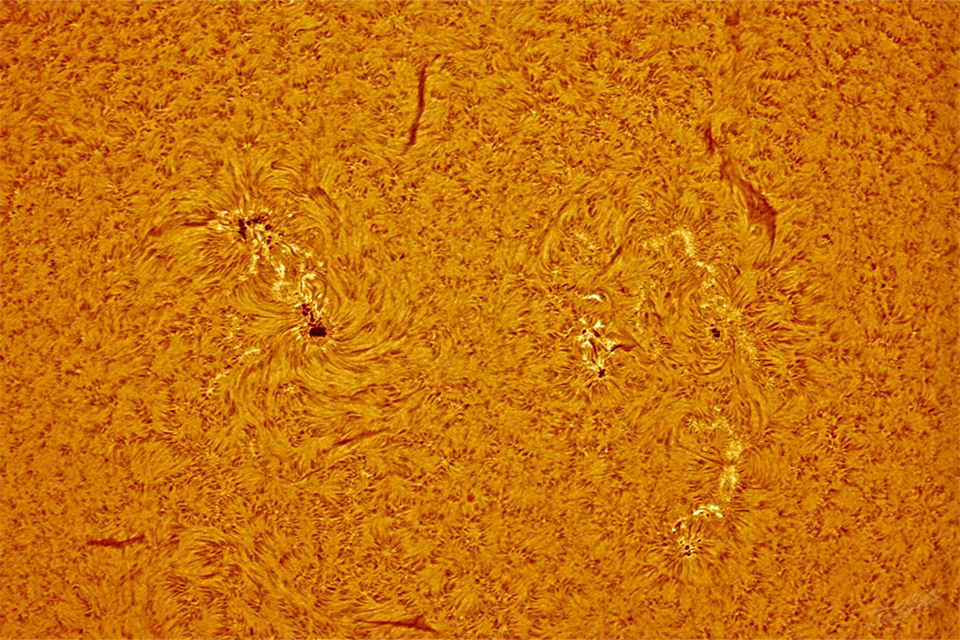ESA Vigil
Monitoring the Sun’s activity to provide space weather forecasts and warnings of extreme space weather events to protect society and infrastructure on Earth.

Artist impression of the Vigil mission at Lagrange point 5. Image credit: Airbus
Launch is planned by the end of 2031, followed by 3 years of cruise to the correct position, with 7.5 years of operation and a possible 5-year extension.
Protecting us from the Sun
Solar storms can have disastrous impacts on infrastructure we rely on every day, such as satellite communications and GPS systems. Understanding when these peaks of solar activity are happening and having the tools to predict them will allow us to be able to prepare and prevent potential damage.
The Vigil mission is a space weather mission developed by the European Space Agency (ESA), which will monitor and identify threats to mitigate potential damage to ground, airborne and space-based infrastructure, providing space weather forecasts up to 5 days ahead.
What are the instruments measuring
Vigil will sit at Lagrange point 5, a point which trails about 60 degrees behind Earth in its orbit around the Sun. From this position, Vigil will be able to observe events on the surface of the Sun before it rotates to face the Earth, giving it the ability to spot dangers early and provide Earth with warnings and time to prepare.
Vigil will observe and monitor the Sun’s surface, the solar corona and the interplanetary medium between the Sun and Earth. It will look for events such as solar flares, coronal mass ejections (CME), geomagnetic storms and solar proton events.
Data from these measurements will stream into ESA’s Space Weather Service Network, where it will be processed and shared freely, providing forecasts and warnings of space weather that could pose a threat to infrastructure.

A close up image of the Sun’s surface, showing a golden surface with dark, blotchy sunspots and lighter patches called ‘plages’. Sunspots and active regions can be the source of solar flare eruptions. Image credit: ESA/ESAC/CESAR – A. de Burgos
The instruments
Vigil’s payload will include 4 remote sensing instruments and 2 in-situ instruments.
Remote sensing instruments
The remote sensing instruments will allow Vigil to estimate the size, mass, speed, and direction of CMEs:
Compact Coronagraph (CCOR)
Imaging the solar corona can be used to observe Coronal Mass Ejections (CMEs). With CCOR data the size, mass, speed, and direction of CMEs can be derived. This instrument is being contributed by the US National Oceanic and Atmospheric Administration (NOAA).
Heliospheric Imager (HI)
Wide-angle, white-light images of the region of space between the Sun and the Earth (heliosphere). This will allow CMEs moving towards Earth to be tracked once they leave the field of view of the COOR. This instrument is being developed by Leonardo SpA, as part of the Vigil Programme.
Photospheric Magnetic field Imager (PMI)
Generating 3D maps of the magnetic field and its physical parameters by scanning a selected solar spectrum, for enhanced space weather applications. This instrument is being developed through the Max Plank Institute in Germany, in collaboration with the Spanish Space Agency.
EUV Imager JEDI
An instrument that observes the sun in the ultraviolet region to detect evolving activity in the chromosphere / low corona of the Sun’s atmosphere including prominences (an early signature of CME eruption), active regions, coronal holes and solar flares. This instrument is being contributed by NASA.
In-situ instruments
The in-situ instruments will measure the Stream Interaction Region (SIR) and Co-rotating Interaction Region (CIR) of solar winds, key properties that can dictate their potential threat, 4 to 5 days before they reach Earth:
Plasma Analyser (PLA)
Measuring the bulk values for velocity, density and temperature of solar winds.
Magnetometer (MAG)
Placed on the end of a 7 metre-long boom, measuring the interplanetary magnetic field at Lagrange point 5, to account for and reduce electromagnetic interference produced by Vigil and its activity on measurements to be sent back to Earth.
How is the UK involved?
The UK has played a leading role in the development of the Vigil mission through ESA and is contributing hardware components and instruments to the mission, as well as providing around half of the funding.
Airbus Defence and Space has been selected by ESA to design and build the spacecraft, with the majority of this work taking place in Stevenage, Hertfordshire. This will sustain more than 150 highly skilled jobs and reinforce Airbus UK’s position as a space prime, covering complete missions from spacecraft design and build to comprehensive verification and final delivery.
The Plasma Analyser (PLA) instrument is being developed by the UCL (University College London) Mullard Space Science Laboratory.
The Magnetometer (MAG) is being developed by Imperial College London.
The Met Office will use the data from Vigil to offer more accurate forecasts, which also feeds into the UK’s National Space Operations Centre.